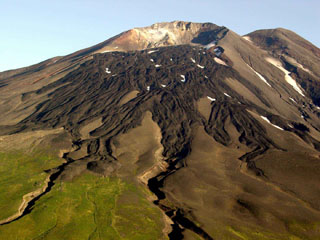Report on Gareloi (United States) — August 1987
Scientific Event Alert Network Bulletin, vol. 12, no. 8 (August 1987)
Managing Editor: Lindsay McClelland.
Gareloi (United States) Narrow steaming flow-like feature
Please cite this report as:
Global Volcanism Program, 1987. Report on Gareloi (United States) (McClelland, L., ed.). Scientific Event Alert Network Bulletin, 12:8. Smithsonian Institution. https://doi.org/10.5479/si.GVP.SEAN198708-311070
Gareloi
United States
51.79°N, 178.794°W; summit elev. 1573 m
All times are local (unless otherwise noted)
On 4 September 1987 at 1500, flight engineer George Wooliver (Reeve Aleutian Airways) observed a narrow flow-like feature that had descended the E flank, from the N crater rim at 1,500 m elevation to at least 1,100 m. A thick cloud cover obscured it below that level. Steam was rising as much as 100 m above the flow feature along its entire visible length. Steaming from the crater appeared more vigorous than usual.
Geological Summary. The 8 x 10 km Gareloi Island, the northernmost volcano of the Delarof Group at the western end of the Andreanof Islands, consists of a stratovolcano with two summits and a prominent SE-trending fissure. The fissure was formed during an eruption in 1929 and extends from the southern summit to the sea. Steep sea cliffs that are cut into rocks of an older, eroded center are found on the SW coast, and submarine deposits of three debris avalanches produced by edifice collapse are found offshore. Young lava flows cover the older volcano from the summit to the coast along three broad axes trending NW, ENE, and S. The 1929 eruption originated from 13 craters along a 4-km-long fissure. Phreatic explosions were followed by the ejection of glassy pumice, lapilli, scoria, and older blocks, as well as by the emission of four short, steep lava flows, one of which reached the SE coast.
Information Contacts: J. Reeder, ADGGS.

